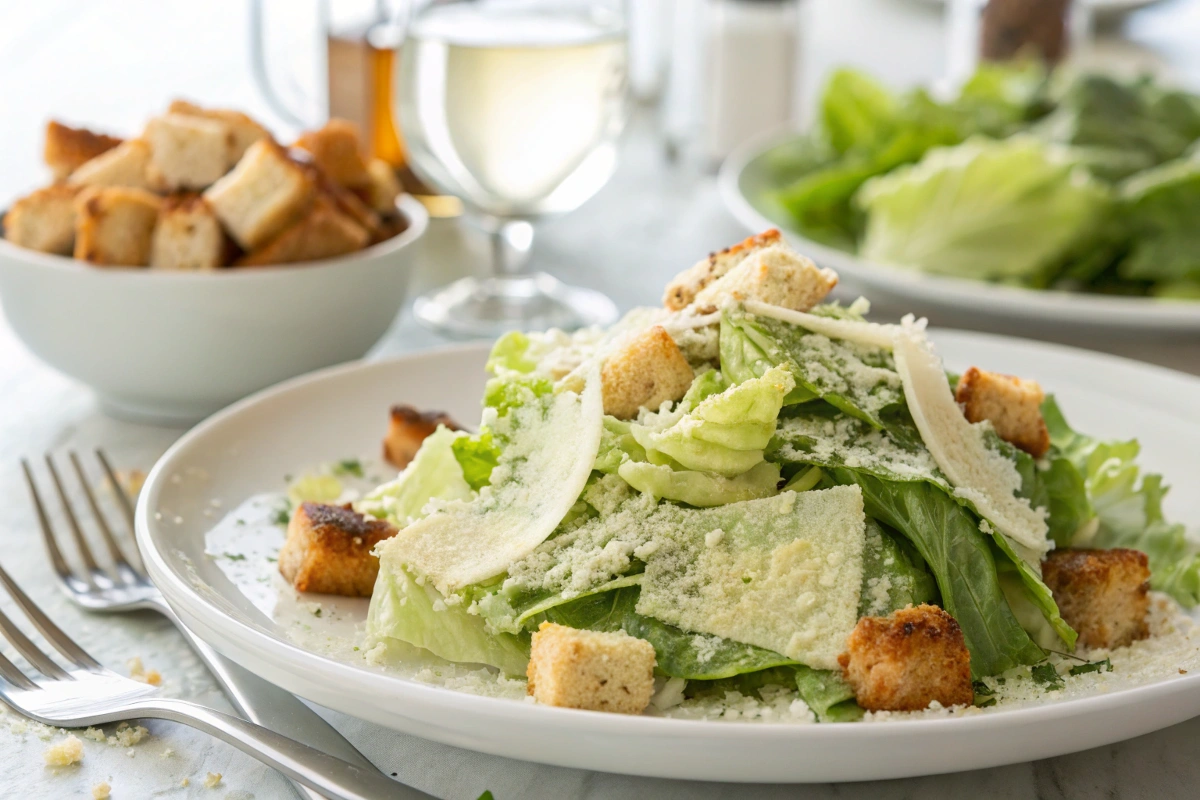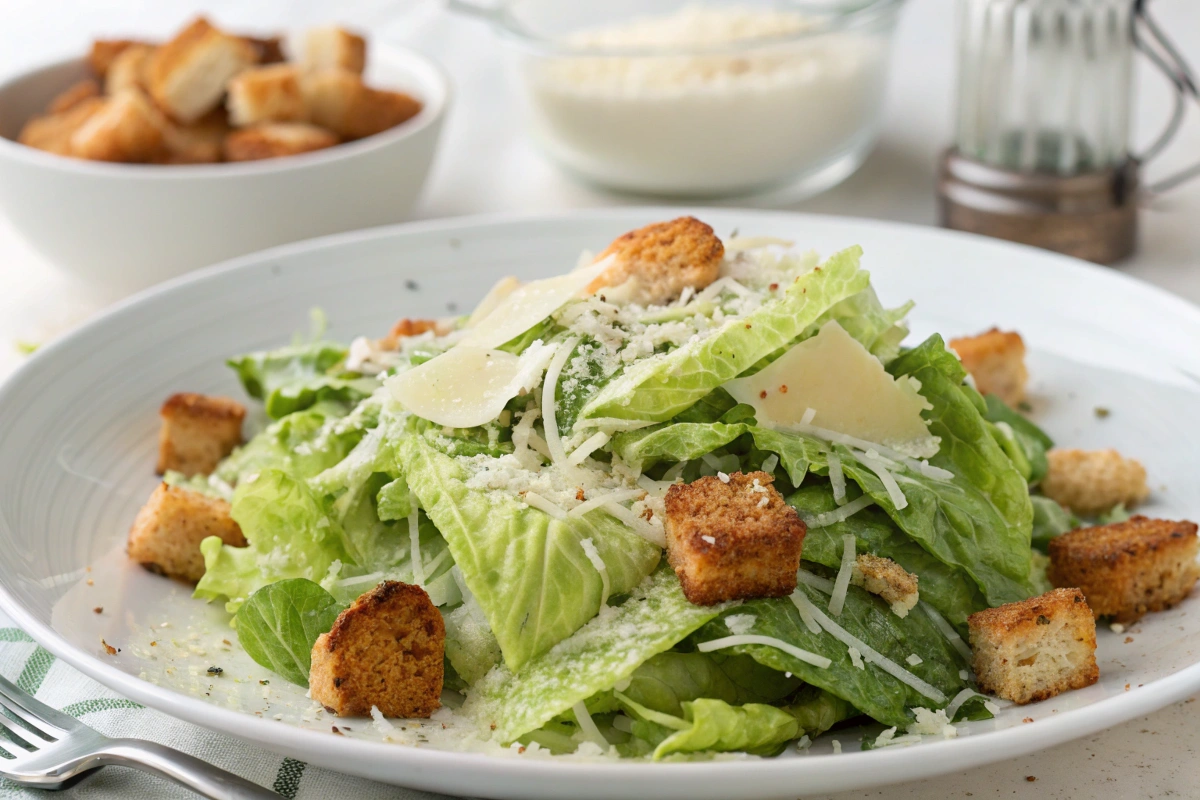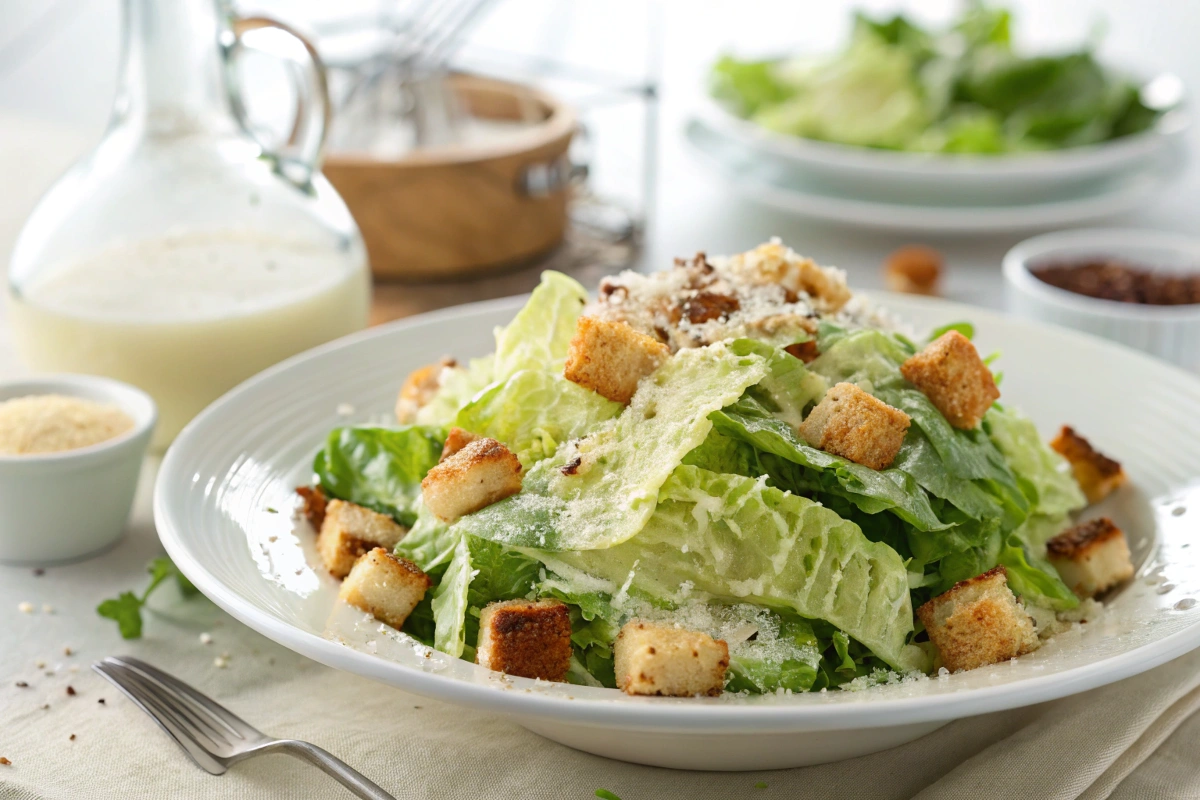Is caesar salad a Mexican salad? This article explores the origins of this popular dish. We’ll uncover its history and also its global appeal. Therefore, you will learn the true story of caesar salad.
The Mystery of Caesar Salad: Is It Mexican?
Many people wonder, is caesar salad a Mexican salad? The answer, surprisingly, is no. Caesar salad, despite its strong association with Mexican food, actually has Italian roots. Its creation took place in Tijuana, Mexico, however. This may be why it causes some confusion. Understanding this origin is crucial to appreciating its story.
Caesar Salad’s Surprising Beginnings
The history of caesar salad is quite interesting. It began in the 1920s at Caesar Cardini’s restaurant in Tijuana, Mexico. Cardini, an Italian immigrant, therefore, created it during a busy holiday weekend. He had limited supplies on hand, so he made do. The result was the caesar salad, as we know it. Its simple but flavorful combination, hence, became an instant hit.
Caesar Salad’s Rapid Rise to Fame
After its creation, caesar salad quickly gained popularity. Celebrities and food enthusiasts alike all praised it. Consequently, it was featured in many publications. Caesar salad spread far beyond Tijuana, and soon became a global favorite. It was a popular salad, not just in Mexico. For example, high-end restaurants across the U.S. began to serve it. Moreover, its simple yet elegant presentation made it a staple at social gatherings and events.
The Confusion: Why the “Mexican Salad” Idea?
So, why do so many think caesar salad is a Mexican salad? The confusion is understandable, given its birth in Mexico. The restaurant in Tijuana, a Mexican border town, was where it was born. The use of some ingredients common in Mexico, additionally, further fuels this misconception. Some also think it’s Mexican simply due to the name ‘Caesar’. Caesar salad’s roots are more complex, however. Its place of origin, at times, can mislead people about its cultural background. This emphasizes why looking deeper into its origin is so important.
Geographical Misconceptions about Caesar Salad
Tijuana is in Mexico, so it seems caesar salad would be a Mexican salad. However, it’s important to look at the creator’s background. Cardini, an Italian immigrant, created this salad. The location, therefore, does not change its true origins. Similarly, Italian cuisine is separate from Mexican. The salad’s core ingredients also show its difference from typical Mexican fare. Consequently, we need to consider the creator’s background.
Ingredients: Not Traditionally Mexican
The original caesar salad used simple components. Romaine lettuce, croutons, Parmesan cheese, and a creamy dressing were in it. These are not typically found in traditional Mexican cuisine. Therefore, it’s incorrect to label it as a Mexican salad. The ingredients, for example, reveal its true nature. These are, additionally, more associated with European and Mediterranean dishes. This further clarifies the salad’s non-Mexican identity.
Discover more about salads enjoyed in Mexico in our guide to Mexican salads.
Analyzing Caesar Salad’s Ingredients
Let’s examine the ingredients of the classic caesar salad. This helps to see why it isn’t a Mexican salad. Each element plays a key role. We can appreciate this through the original recipe. Caesar salad is about a balance of fresh, flavorful components. The selection of each element contributes to its unique taste and texture. This aspect makes it so special.
The Foundation: Romaine Lettuce
Romaine lettuce forms the base of caesar salad. It provides a crisp, fresh foundation, therefore. This type of lettuce is not unique to Mexican cuisine. For example, it is used in salads all over the world. The use of romaine is a key ingredient, not especially Mexican. It’s a versatile lettuce, but it does not define Mexican salads. Therefore, it’s not a strong link.
The Croutons: A Crunchy Addition
Croutons add a crunchy texture to the caesar salad. Typically, they are made from toasted or fried bread. This is a simple, yet important, part of caesar salad. Croutons are not traditionally a key part of Mexican salads. The addition, therefore, is more of a European influence. They contribute to the overall texture and the flavor profile. Furthermore, this is a clear distinction from Mexican salads.
The Cheese: Parmesan’s Signature
Parmesan cheese is the main cheese for caesar salad. Its salty and nutty flavors enhance the salad. Parmesan is, therefore, of Italian origin. It’s another reason that caesar salad is not Mexican. The cheese itself is a very clear marker. This type of cheese is seldom used in Mexican culinary traditions. Consequently, it adds to the non-Mexican feel.
The Dressing: Creamy and Tangy
The dressing gives caesar salad its unique flavor. It is usually a combination of eggs, oil, lemon juice, garlic, and Worcestershire sauce. These ingredients create a creamy, tangy taste that is signature to caesar salad. It’s a combination of flavors that are not rooted in Mexican cooking. These aspects indicate that this dish is not Mexican. The tangy flavor profile is very different from Mexican dressings. Moreover, the inclusion of Worcestershire sauce is a European touch.
Distinguishing Caesar Salad from Mexican Salads
There are clear distinctions between caesar salad and Mexican salads. This comparison will clarify why caesar salad is not Mexican. Exploring different salad styles can show this. We will look at some common traits. The differences are not just in the main ingredients but also in their overall style. This will underline the unique qualities of each style.
Key Differences in Ingredients
Mexican salads use ingredients such as corn, beans, avocados, and peppers. These are rare to non-existent in caesar salad. Instead, caesar salad relies on more simple, European-style components. This difference in ingredients is, therefore, an important aspect. Mexican salads usually include a wide variety of vegetables and legumes. This stands in contrast to the simplicity of the caesar salad.
Difference in Flavors and Spices
Mexican salads also incorporate bold spices and herbs. Cumin, chili powder, and cilantro are very common. Caesar salad, however, does not have these flavors. Its taste is tangy and creamy, very different from the spice of Mexican salads. Therefore, the flavors set them apart. The emphasis on fresh herbs and spicy elements is a key element in Mexican cuisine. Therefore, these elements are absent in caesar salad.
Preparation Methods Vary
The preparation methods also differ greatly. Mexican salads often have grilled or roasted components. Caesar salad is very seldom cooked. This adds another layer to its clear differences. Thus, preparation methods emphasize the salad’s non-Mexican roots. This aspect showcases how different culinary cultures apply different preparation styles. These contrasting methods further set them apart.
Common Caesar Salad Variations
While the classic caesar salad remains popular, there are many variations. These can include other proteins and different toppings. Exploring these changes may even lead to confusion. The base remains quite unique, however. These variations show how adaptable the recipe can be. Yet, they always maintain the core elements of the original caesar salad.
Chicken Caesar Salad : A Popular Addition
Adding grilled chicken to caesar salad is very common. This provides a boost of protein, therefore. Many people prefer this for a full meal. Chicken enhances the salad while keeping the essence of caesar salad. It is a straightforward addition that improves nutritional content, while retaining the unique qualities of caesar salad.
Shrimp Caesar Salad: Seafood twist
Another variation is shrimp caesar salad. This adds a different kind of protein to the mix. The seafood gives the salad a more sophisticated feel. It’s another twist that’s popular, while remaining true to the original version. Shrimp, moreover, provides a light and elegant touch to the salad. This shows the salad’s adaptability.
Other Toppings and Add-ins
Some caesar salad variations include other toppings. For example, some may add tomatoes or cucumbers. While these additions are not traditional, they provide some variety. Each version, however, has a base similar to the original recipe. This is why caesar salad is not generally confused as a Greek salad either, despite the addition of other ingredients. Therefore, these modifications maintain the unique identity of a caesar salad.
Caesar Salad : A Global Dish
The popularity of caesar salad extends far beyond its creation. It’s an internationally loved dish. Restaurants all over the world have it on their menu. It’s not unique to just Mexico, therefore. Caesar salad’s global reach also shows its story. Its ability to please different palates is quite remarkable. Furthermore, its adaptability shows its universal appeal.
Caesar Salad’s International Appeal
Caesar salad’s simple yet rich flavor appeals to many. Its balance of textures and tastes, therefore, is universally loved. Restaurants all around the world offer caesar salad. This is a testament to its broad appeal, proving it is not just a Mexican salad. It transcends cultural boundaries. It is a dish that people around the world enjoy.
Caesar Salad on Menus Worldwide
You can find caesar salad on menus in almost every country. It’s a classic salad with a unique story. From casual eateries to high-end restaurants, caesar salad is a staple. This indicates its global popularity, and its separation from Mexican salads. Its consistency in taste and texture makes it a safe and loved choice. This makes it an appealing menu option for restaurants worldwide.
Adaptations and Local Twists
In some regions, they make adaptations of caesar salad. These may use local ingredients, however. The core elements, however, usually remain the same. This adaptability, therefore, showcases the dish’s global status. The result is a salad loved worldwide, and very distant from a Mexican salad. These local adaptations enhance its international character. Thus, it becomes a flexible dish.
The True Identity of Caesar Salad
To truly appreciate caesar salad, we must understand its true identity. Despite its Mexican origin, it is not a Mexican salad. Its Italian roots give it a unique characteristic. Caesar salad is a product of culinary innovation. It combines simple ingredients, for a delicious result. This reflects a combination of influences. It is a culinary creation that has evolved.
Italian Roots, Mexican Birthplace
Cardini, an Italian immigrant, created caesar salad. The restaurant in Tijuana was in Mexico. These factors all contribute to its unique history. It’s an example of how different cultures can blend. But its main influence is, therefore, from Italy. It combines the creator’s heritage, with the place it was born. This helps in understanding the true nature of caesar salad.
Not a Traditional Mexican Dish
The ingredients and preparation of caesar salad do not align with Mexican traditions. This helps in clarifying its true nature. Its flavor profile, therefore, stands apart from Mexican cuisine. The simple fact is caesar salad is simply not a Mexican salad. The culinary differences are quite pronounced. Therefore, there should be no confusion.
A Salad With a Rich History
The story of caesar salad is one of culinary creativity. It’s a dish that has overcome geographical boundaries. The legacy of this salad continues to grow. Caesar salad remains popular even after many years. It is a perfect example of how food can connect us all. This lasting appeal proves its timelessness. Its history adds to its overall charm.
Frequently Asked Questions (FAQs)
Is Caesar salad a Mexican salad?
No, caesar salad is not a Mexican salad, despite its creation in Tijuana, Mexico. Its creator was an Italian immigrant and the recipe and ingredients are not reflective of traditional Mexican cuisine. It’s important to consider both the creator and the recipe’s characteristics.
Where was caesar salad actually invented?
Caesar salad was invented in Tijuana, Mexico, at Caesar Cardini’s restaurant in the 1920s. However, the creator was Italian and this is reflected in the recipes. This explains the mixed understanding about its true origin.
What makes Caesar salad different from a typical Mexican salad?
Caesar salad uses ingredients like romaine lettuce, croutons, Parmesan cheese, and a creamy dressing. In contrast, typical Mexican salads include ingredients such as corn, beans, avocados, and peppers. The flavor and spice profiles are very different too. These contrasting elements make it easy to separate them.
Is it correct to call it an Italian Salad then?
While the creator of Caesar salad was Italian and his heritage is present in the salad’s recipe, it’s not traditionally considered an ‘Italian salad.’ Rather, Caesar salad is considered to have its own unique identity. It’s a unique creation with combined influences.
Is Caesar Salad a Mexican Salad? – Conclusion
So, is caesar salad a Mexican salad? The answer is definitively no. The caesar salad, with Italian roots, was born in Tijuana, Mexico. Its creator was Italian. The dish’s ingredients, however, are not traditionally Mexican. It’s a popular dish globally, with many variations. Caesar salad, therefore, has a unique story and should not be confused as a Mexican salad. Its unique taste, texture, and origin make it a dish with a distinct identity. We have shown how its history, ingredients, and preparation methods differ from those of Mexican cuisine. It’s a great example of a dish that has spread worldwide while maintaining its core identity.
Check out what salads they eat in Mexico and the 5 types of salads.




